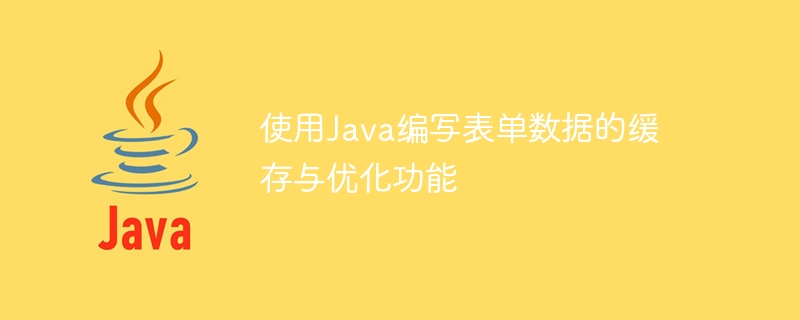

Use Java to write form data caching and optimization functions
In modern web development, the processing of form data is a very common task. However, as the number of users and concurrent requests increases, processing form data can become very time-consuming and resource-intensive. In order to improve the performance and response speed of the system, caching and optimizing the processing of form data are essential.
This article will introduce how to use Java to write the caching and optimization functions of form data. We will implement a simple example including caching, loading and updating form data. We will use the Spring framework to simplify the development process.
First, we need to define a form data class and the corresponding cache class. Let's say our form data contains usernames and email addresses. The code example is as follows:
public class FormData {
private String username;
private String email;
// 构造函数、getter和setter方法省略
@Override
public String toString() {
return "FormData{" +
"username='" + username + ''' +
", email='" + email + ''' +
'}';
}
}
public class FormDataCache {
private static Map cache = new ConcurrentHashMap<>();
public static FormData getFormDataById(Long id) {
return cache.get(id);
}
public static void putFormData(FormData formData) {
cache.put(formData.getId(), formData);
}
public static void removeFormDataById(Long id) {
cache.remove(id);
}
public static List getAllFormData() {
return new ArrayList<>(cache.values());
}
} Next, we create a Controller class to handle requests for form data. We use annotations to identify the requested URL and processing method, and inject FormDataCache into the Controller for operation. The code example is as follows:
@RestController
@RequestMapping("/form")
public class FormController {
@Autowired
private FormDataCache formDataCache;
@GetMapping("/{id}")
public FormData getFormDataById(@PathVariable Long id) {
return formDataCache.getFormDataById(id);
}
@PostMapping("/")
public void createFormData(@RequestBody FormData formData) {
formDataCache.putFormData(formData);
}
@PutMapping("/{id}")
public void updateFormDataById(@PathVariable Long id, @RequestBody FormData formData) {
formData.setId(id);
formDataCache.putFormData(formData);
}
@DeleteMapping("/{id}")
public void deleteFormDataById(@PathVariable Long id) {
formDataCache.removeFormDataById(id);
}
@GetMapping("/")
public List getAllFormData() {
return formDataCache.getAllFormData();
}
} Finally, we need to configure the Spring context and web processor in order to start our application. The code example is as follows:
@Configuration
@EnableWebMvc
@ComponentScan(basePackages = "com.example.form")
public class AppConfig implements WebMvcConfigurer {
@Bean
public FormDataCache formDataCache() {
return new FormDataCache();
}
@Override
public void addViewControllers(ViewControllerRegistry registry) {
registry.addViewController("/").setViewName("index");
}
}
public class WebAppInitializer implements WebApplicationInitializer {
@Override
public void onStartup(ServletContext servletContext) throws ServletException {
AnnotationConfigWebApplicationContext context = new AnnotationConfigWebApplicationContext();
context.register(AppConfig.class);
context.setServletContext(servletContext);
ServletRegistration.Dynamic dispatcher = servletContext.addServlet("dispatcherServlet", new DispatcherServlet(context));
dispatcher.setLoadOnStartup(1);
dispatcher.addMapping("/");
}
}Through the above steps, we have completed the implementation of a simple form data caching and optimization function. We can use tools such as Postman to simulate requests and test our applications.
Summary: This article introduces how to use Java to write the caching and optimization functions of form data. By caching data in memory, we can significantly reduce access to the database or other external storage and improve the performance and responsiveness of the system. In actual development, we can decide whether further optimization is needed based on the actual situation, such as increasing the expiration time of data, using distributed cache, etc., to meet the application's needs for form data processing.
The above is the detailed content of Use Java to write caching and optimization functions of form data. For more information, please follow other related articles on the PHP Chinese website!




